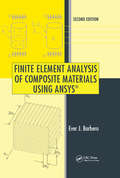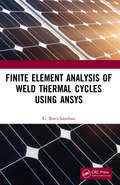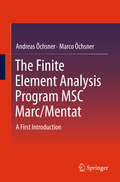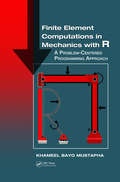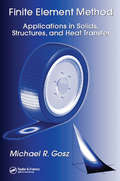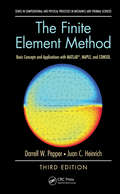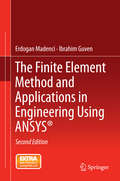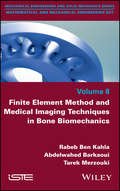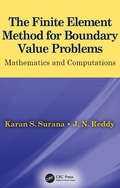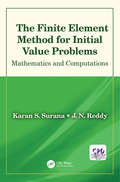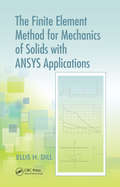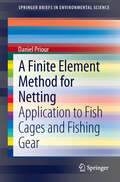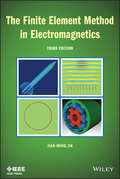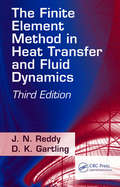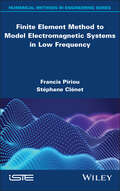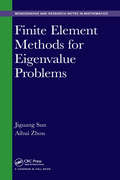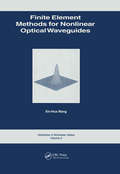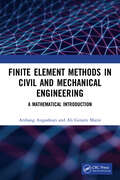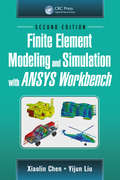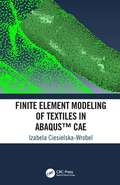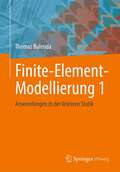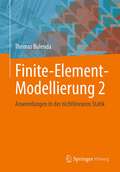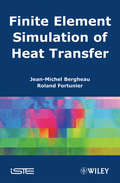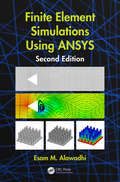- Table View
- List View
Finite Element Analysis of Composite Materials Using ANSYS
by Ever J. BarberoDesigning structures using composite materials poses unique challenges, especially due to the need for concurrent design of both material and structure. Students are faced with two options: textbooks that teach the theory of advanced mechanics of composites, but lack computational examples of advanced analysis, and books on finite element analysis
Finite Element Analysis of Weld Thermal Cycles Using ANSYS
by G. RavichandranFinite Element Analysis of Weld Thermal Cycles Using ANSYS aims at educating a young researcher on the transient analysis of welding thermal cycles using ANSYS. It essentially deals with the methods of calculation of the arc heat in a welded component when the analysis is simplified into either a cross sectional analysis or an in-plane analysis. The book covers five different cases involving different welding processes, component geometry, size of the element and dissimilar material properties. A detailed step by step calculation is presented followed by APDL program listing and output charts from ANSYS. Features: Provides useful background information on welding processes, thermal cycles and finite element method Presents calculation procedure for determining the arc heat input in a cross sectional analysis and an in-plane analysis Enables visualization of the arc heat in a FEM model for various positions of the arc Discusses analysis of advanced cases like dissimilar welding and circumferential welding Includes step by step procedure for running the analysis with typical input APDL program listing and output charts from ANSYS.
The Finite Element Analysis Program MSC Marc/Mentat
by Andreas Öchsner Marco ÖchsnerBased on simple examples, this book offers a short introduction to the general-purpose finite element program MSC Marc, a specialized program for non-linear problems (implicit solver) distributed by the MSC Software Corporation, which is commonly used in academia and industry. Today the documentation of all finite element programs includes a variety of step-by-step examples of differing complexity, and in addition, all software companies offer professional workshops on different topics. As such, rather than competing with these, the book focuses on providing simple examples, often single-element problems, which can easily be related to the theory that is discussed in finite element lectures. This makes it an ideal companion book to classical introductory courses on the finite element method.
Finite Element Computations in Mechanics with R: A Problem-Centered Programming Approach
by Khameel Bayo MustaphaFinite Element Computations in Mechanics with R: A Problem-Centred Programming Approach provides introductory coverage of the finite element method (FEM) with the R programming language, emphasizing links between theory and implementation of FEM for problems in engineering mechanics. Useful for students, practicing engineers, and researchers, the text presents the R programming as a convenient easy-to-learn tool for analyzing models of mechanical systems, with finite element routines for structural, thermal, and dynamic analyses of mechanical systems, and also visualization of the results. Full-color graphics are used throughout the text.
Finite Element Method: Applications in Solids, Structures, and Heat Transfer (Mechanical Engineering)
by Michael R. GoszThe finite element method (FEM) is the dominant tool for numerical analysis in engineering, yet many engineers apply it without fully understanding all the principles. Learning the method can be challenging, but Mike Gosz has condensed the basic mathematics, concepts, and applications into a simple and easy-to-understand reference.Finite Element Method: Applications in Solids, Structures, and Heat Transfer navigates through linear, linear dynamic, and nonlinear finite elements with an emphasis on building confidence and familiarity with the method, not just the procedures. This book demystifies the assumptions made, the boundary conditions chosen, and whether or not proper failure criteria are used. It reviews the basic math underlying FEM, including matrix algebra, the Taylor series expansion and divergence theorem, vectors, tensors, and mechanics of continuous media.The author discusses applications to problems in solid mechanics, the steady-state heat equation, continuum and structural finite elements, linear transient analysis, small-strain plasticity, and geometrically nonlinear problems. He illustrates the material with 10 case studies, which define the problem, consider appropriate solution strategies, and warn against common pitfalls. Additionally, 35 interactive virtual reality modeling language files are available for download from the CRC Web site.For anyone first studying FEM or for those who simply wish to deepen their understanding, Finite Element Method: Applications in Solids, Structures, and Heat Transfer is the perfect resource.
The Finite Element Method: Basic Concepts and Applications with MATLAB, MAPLE, and COMSOL (3rd Edition) (Series in Computational and Physical Processes in Mechanics and Thermal Sciences)
by Darrell W. Pepper Juan C. Heinrich<p>This self-explanatory guide introduces the basic fundamentals of the Finite Element Method in a clear manner using comprehensive examples. Beginning with the concept of one-dimensional heat transfer, the first chapters include one-dimensional problems that can be solved by inspection. The book progresses through more detailed two-dimensional elements to three-dimensional elements, including discussions on various applications, and ending with introductory chapters on the boundary element and meshless methods, where more input data must be provided to solve problems. Emphasis is placed on the development of the discrete set of algebraic equations. The example problems and exercises in each chapter explain the procedure for defining and organizing the required initial and boundary condition data for a specific problem, and computer code listings in MATLAB and MAPLE are included for setting up the examples within the text, including COMSOL files. <p>Widely used as an introductory Finite Element Method text since 1992 and used in past ASME short courses and AIAA home study courses, this text is intended for undergraduate and graduate students taking Finite Element Methodology courses, engineers working in the industry that need to become familiar with the FEM, and engineers working in the field of heat transfer. It can also be used for distance education courses that can be conducted on the web. Highlights of the new edition include:- Inclusion of MATLAB, MAPLE code listings, along with several COMSOL files, for the example problems within the text. Power point presentations per chapter and a solution manual are also available from the web.</p>
The Finite Element Method and Applications in Engineering Using ANSYS®
by Ibrahim Guven Erdogan MadenciThis textbook offers theoretical and practical knowledge of the finite element method. The book equips readers with the skills required to analyze engineering problems using ANSYS®, a commercially available FEA program. Revised and updated, this new edition presents the most current ANSYS® commands and ANSYS® screen shots, as well as modeling steps for each example problem. This self-contained, introductory text minimizes the need for additional reference material by covering both the fundamental topics in finite element methods and advanced topics concerning modeling and analysis. It focuses on the use of ANSYS® through both the Graphics User Interface (GUI) and the ANSYS® Parametric Design Language (APDL). Extensive examples from a range of engineering disciplines are presented in a straightforward, step-by-step fashion. Key topics include: * An introduction to FEM * Fundamentals and analysis capabilities of ANSYS® * Fundamentals of discretization and approximation functions * Modeling techniques and mesh generation in ANSYS® * Weighted residuals and minimum potential energy * Development of macro files * Linear structural analysis * Heat transfer and moisture diffusion * Nonlinear structural problems * Advanced subjects such as submodeling, substructuring, interaction with external files, and modification of ANSYS®-GUI Supplementary materials for this book may be downloaded from http://extras. springer. com. This convenient online feature, which includes color figures, screen shots and input files for sample problems, allows for regeneration on the reader's own computer. Students, researchers, and practitioners alike will find this an essential guide to predicting and simulating the physical behavior of complex engineering systems.
Finite Element Method and Medical Imaging Techniques in Bone Biomechanics
by Rabeb Ben Kahla Abdelwahed Barkaoui Tarek MerzoukiDigital models based on data from medical images have recently become widespread in the field of biomechanics. This book summarizes medical imaging techniques and processing procedures, both of which are necessary for creating bone models with finite element methods. Chapter 1 introduces the main principles and the application of the most commonly used medical imaging techniques. Chapter 2 describes the major methods and steps of medical image analysis and processing. Chapter 3 presents a brief review of recent studies on reconstructed finite element bone models, based on medical images. Finally, Chapter 4 reveals the digital results obtained for the main bone sites that have been targeted by finite element modeling in recent years.
The Finite Element Method for Boundary Value Problems: Mathematics and Computations (Applied and Computational Mechanics)
by Karan S. Surana J. N. ReddyWritten by two well-respected experts in the field, The Finite Element Method for Boundary Value Problems: Mathematics and Computations bridges the gap between applied mathematics and application-oriented computational studies using FEM. Mathematically rigorous, the FEM is presented as a method of approximation for differential operators that are mathematically classified as self-adjoint, non-self-adjoint, and non-linear, thus addressing totality of all BVPs in various areas of engineering, applied mathematics, and physical sciences. These classes of operators are utilized in various methods of approximation: Galerkin method, Petrov-Galerkin Method, weighted residual method, Galerkin method with weak form, least squares method based on residual functional, etc. to establish unconditionally stable finite element computational processes using calculus of variations. Readers are able to grasp the mathematical foundation of finite element method as well as its versatility of applications. h-, p-, and k-versions of finite element method, hierarchical approximations, convergence, error estimation, error computation, and adaptivity are additional significant aspects of this book.
The Finite Element Method for Initial Value Problems: Mathematics and Computations
by Karan S. Surana J. N. Reddy<p>Unlike most finite element books that cover time dependent processes (IVPs) in a cursory manner, The Finite Element Method for Initial Value Problems: Mathematics and Computations focuses on the mathematical details as well as applications of space-time coupled and space-time decoupled finite element methods for IVPs. Space-time operator classification, space-time methods of approximation, and space-time calculus of variations are used to establish unconditional stability of space-time methods during the evolution. Space-time decoupled methods are also presented with the same rigor. Stability of space-time decoupled methods, time integration of ODEs including the finite element method in time are presented in detail with applications. Modal basis, normal mode synthesis techniques, error estimation, and a posteriori error computations for space-time coupled as well as space-time decoupled methods are presented. This book is aimed at a second-semester graduate level course in FEM.
The Finite Element Method for Mechanics of Solids with ANSYS Applications (Advances in Engineering Series)
by Ellis H. DillWhile the finite element method (FEM) has become the standard technique used to solve static and dynamic problems associated with structures and machines, ANSYS software has developed into the engineer's software of choice to model and numerically solve those problems. An invaluable tool to help engineers master and optimize analysis, The Finite El
A Finite Element Method for Netting: Application to fish cages and fishing gear (SpringerBriefs in Environmental Science)
by Daniel PriourThis book fully describes a finite element method for netting. That describes the relation between forces and deformation of the netting. That takes into account forces due to the twine elasticity, the hydrodynamic forces, the catch effect, the mesh opening stiffness. This book is divided in 5 parts. The first section contains introduction on the finite element method, the second part is about equilibrium calculation, the third presents a triangular element for netting, the fourth and fifth are for cable and node element. The sixth presents few validation cases.
The Finite Element Method in Electromagnetics (Wiley - IEEE)
by Jianming JinA new edition of the leading textbook on the finite element method, incorporating major advancements and further applications in the field of electromagneticsThe finite element method (FEM) is a powerful simulation technique used to solve boundary-value problems in a variety of engineering circumstances. It has been widely used for analysis of electromagnetic fields in antennas, radar scattering, RF and microwave engineering, high-speed/high-frequency circuits, wireless communication, electromagnetic compatibility, photonics, remote sensing, biomedical engineering, and space exploration.The Finite Element Method in Electromagnetics, Third Edition explains the method's processes and techniques in careful, meticulous prose and covers not only essential finite element method theory, but also its latest developments and applications--giving engineers a methodical way to quickly master this very powerful numerical technique for solving practical, often complicated, electromagnetic problems.Featuring over thirty percent new material, the third edition of this essential and comprehensive text now includes:A wider range of applications, including antennas, phased arrays, electric machines, high-frequency circuits, and crystal photonicsThe finite element analysis of wave propagation, scattering, and radiation in periodic structuresThe time-domain finite element method for analysis of wideband antennas and transient electromagnetic phenomenaNovel domain decomposition techniques for parallel computation and efficient simulation of large-scale problems, such as phased-array antennas and photonic crystalsAlong with a great many examples, The Finite Element Method in Electromagnetics is an ideal book for engineering students as well as for professionals in the field.
The Finite Element Method in Heat Transfer and Fluid Dynamics (Applied and Computational Mechanics)
by J. N. Reddy D.K. GartlingAs Computational Fluid Dynamics (CFD) and Computational Heat Transfer (CHT) evolve and become increasingly important in standard engineering design and analysis practice, users require a solid understanding of mechanics and numerical methods to make optimal use of available software. Considered to be among the very best in the field, this masterwork from renowned experts J. N. Reddy and D. K. Gartling is the latest version of a book that has long been relied upon by practicing engineers, researchers, and graduate students. Noted for its powerful methodology and clear explanations of the subject, this third edition contains considerably more workable exercises and examples associated with problems in heat conduction, incompressible viscous flow, and convection heat transfer. It also uses applied examples to illustrate applications of FEM in thermal and fluid design analysis.
Finite Element Method to Model Electromagnetic Systems in Low Frequency
by Francis Piriou Stéphane ClénetNumerical modeling now plays a central role in the design and study of electromagnetic systems. In the field of devices operating in low frequency, it is the finite element method that has come to the fore in recent decades. Today, it is widely used by engineers and researchers in industry, as well as in research centers. This book describes in detail all the steps required to discretize Maxwell’s equations using the finite element method. This involves progressing from the basic equations in the continuous domain to equations in the discrete domain that are solved by a computer. This approach is carried out with a constant focus on maintaining a link between physics, i.e. the properties of electromagnetic fields, and numerical analysis. Numerous academic examples, which are used throughout the various stages of model construction, help to clarify the developments.
The Finite Element Method with Heat Transfer and Fluid Mechanics Applications
by Erian A. BaskharoneIntended for advanced undergraduate and graduate students, the first four chapters of this book are devoted to the introduction of the finite element concept. The focus then covers two essential areas - heat transfer and fluid mechanics: topics with different finite element formulations. Heat transfer applications begin with the classical one-dimensional thin-rod problem, followed by the two-dimensional heat transfer problem including a variety of boundary conditions. Finally, a complicated-geometry three-dimensional problem, involving a cooled radial turbine rotor, is presented, with the cooling passages treated as 'heat sinks' in the finite element analysis. For fluid mechanics, the concept of 'nodeless' degrees of freedom is introduced, with real-life fluid-flow applications. The time-dependent finite-element analysis topic is addressed through the problem of unsteady stator/rotor flow interaction within a turbomachinery stage. Finally, the concept of 'virtually-deformable finite elements', as it relates to the problem of fluid-induced vibration, is explained in detail with many practical applications.
Finite Element Methods for Eigenvalue Problems (Chapman & Hall/CRC Monographs and Research Notes in Mathematics)
by Jiguang Sun Aihui ZhouThis book covers finite element methods for several typical eigenvalues that arise from science and engineering. Both theory and implementation are covered in depth at the graduate level. The background for typical eigenvalue problems is included along with functional analysis tools, finite element discretization methods, convergence analysis, techniques for matrix evaluation problems, and computer implementation. The book also presents new methods, such as the discontinuous Galerkin method, and new problems, such as the transmission eigenvalue problem.
Finite Element Methods for Nonlinear Optical Waveguides
by Xin-Hua WangThis book provides researchers at the forefront of nonlinear optical technologies with robust procedures and software for the systematic investigation of the fundamental phenomena in nonlinear optical waveguide structures. A full vectorial electromagnetic formulation is adopted and the conditions under which simplification to a scalar formulation is possible are clearly indicated. The need to model the dielectric saturation properly is identified, and improved algorithms are presented for obtaining the complete power dispersion curve of structures exhibiting bistability. As the stability analysis of nonlinear modes is crucial to the development of nonlinear model methods, an effective procedure to investigate the propagation of the scalar nonlinear waves in 3D is another important feature of the book. All of the procedures described, as well as an automatic mesh generator for the finite element method, are incorporated into a software package which is included with this book.
Finite Element Methods in Civil and Mechanical Engineering: A Mathematical Introduction
by Arzhang Angoshtari Ali Gerami MatinThe finite element method is widely employed for numerical simulations in engineering and science due to its accuracy and efficiency. This concise introduction to the mathematical theory of the finite element method presents a selection of applications in civil and mechanical engineering including beams, elastic membranes, the wave equation, heat transfer, seepage in embankment, soil consolidation, incompressible fluids, and linear elasticity. Jupyter notebooks containing all Python programs of each chapter can be downloaded from the book's companion website. Arzhang Angoshtari is an assistant professor and Ali Gerami Matin is a graduate student, both in the department of Civil and Environmental Engineering at the George Washington University, USA. Their research interests cover theoretical and computational mechanics and finite element methods.
Finite Element Modeling and Simulation with ANSYS Workbench, Second Edition
by Xiaolin Chen Yijun LiuFinite Element Modeling and Simulation with ANSYS Workbench 18, Second Edition, combines finite element theory with real-world practice. Providing an introduction to finite element modeling and analysis for those with no prior experience, and written by authors with a combined experience of 30 years teaching the subject, this text presents FEM formulations integrated with relevant hands-on instructions for using ANSYS Workbench 18. Incorporating the basic theories of FEA, simulation case studies, and the use of ANSYS Workbench in the modeling of engineering problems, the book also establishes the finite element method as a powerful numerical tool in engineering design and analysis. Features Uses ANSYS Workbench™ 18, which integrates the ANSYS SpaceClaim Direct Modeler™ into common simulation workflows for ease of use and rapid geometry manipulation, as the FEA environment, with full-color screen shots and diagrams. Covers fundamental concepts and practical knowledge of finite element modeling and simulation, with full-color graphics throughout. Contains numerous simulation case studies, demonstrated in a step-by-step fashion. Includes web-based simulation files for ANSYS Workbench 18 examples. Provides analyses of trusses, beams, frames, plane stress and strain problems, plates and shells, 3-D design components, and assembly structures, as well as analyses of thermal and fluid problems.
Finite Element Modeling of Textiles in Abaqus™ CAE
by Izabela Ciesielska-WrobelThe aim of the book is to provide engineers with a practical guide to Finite Element Modelling (FEM) in Abaqus CAE software. The guide is in the form of step-by-step procedures concerning yarns, woven fabric and knitted fabrics modelling, as well as their contact with skin so that the simulation of haptic perception between textiles and skin can be
Finite-Element-Modellierung 1: Anwendungen in der linearen Statik
by Thomas BulendaEs gibt eine Vielzahl von „Wie-erstelle-ich-ein Finite-Element-Programm?“-Lehrbüchern, aber nur recht wenige Veröffentlichungen zur Frage „Wie wende ich ein Finite-Element-Programm an?“. Dieses Buch legt den Schwerpunkt auf die zweite Fragestellung. Es basiert auf den Vorlesungen zur Anwendung der Finite-Element-Methode, die der Autor seit 1998 an der OTH Regensburg hält. Deren Inhalte kommen aus seiner Tätigkeit als Prüfingenieur für Baustatik in einem großen Münchener Ingenieurbüro. Behandelt werden sowohl Fragestellungen, mit denen sich jeder Ingenieur konfrontiert sieht, wenn er Berechnungen mit einem Finite-Element-Programm erstellen will, als auch Problempunkte, die im Büro des Autors im Zuge einer Projektbearbeitung auftraten und auf den ersten Blick gar nicht so klar waren. In Teil 1 des zweibändigen Werks werden Themen aus der linearen Statik behandelt.
Finite-Element-Modellierung 2: Anwendungen in der nichtlinearen Statik
by Thomas BulendaEs gibt eine Vielzahl von „Wie-erstelle-ich-ein Finite-Element-Programm?“-Lehrbüchern, aber nur recht wenige Veröffentlichungen zur Frage „Wie wende ich ein Finite-Element-Programm an?“. Dieses Buch legt den Schwerpunkt auf die zweite Fragestellung. Es basiert auf den Vorlesungen zur Anwendung der Finite-Element-Methode, die der Autor seit 1998 an der OTH Regensburg hält. Deren Inhalte kommen aus seiner Tätigkeit als Prüfingenieur für Baustatik in einem großen Münchener Ingenieurbüro. Behandelt werden sowohl Fragestellungen, mit denen sich jeder Ingenieur konfrontiert sieht, wenn er Berechnungen mit einem Finite-Element-Programm erstellen will, als auch Problempunkte, die im Büro des Autors im Zuge einer Projektbearbeitung auftraten und auf den ersten Blick gar nicht so klar waren. Der 2.Teil des zweibändigen Werkes befasst sich mit Themen aus der nichtlinearen Statik.
Finite Element Simulation of Heat Transfer
by Jean-Michel Bergheau Roland FortunierThis book introduces the finite element method applied to the resolution of industrial heat transfer problems. Starting from steady conduction, the method is gradually extended to transient regimes, to traditional non-linearities, and to convective phenomena. Coupled problems involving heat transfer are then presented. Three types of couplings are discussed: coupling through boundary conditions (such as radiative heat transfer in cavities), addition of state variables (such as metallurgical phase change), and coupling through partial differential equations (such as electrical phenomena). A review of the various thermal phenomena is drawn up, which an engineer can simulate. The methods presented will enable the reader to achieve optimal use from finite element software and also to develop new applications.
Finite Element Simulations Using ANSYS
by Esam M. AlawadhiUses a Step-By-Step Technique Directed with Guided Problems and Relevant Screen Shots Simulation use is on the rise, and more practicing professionals are depending on the reliability of software to help them tackle real-world mechanical engineering problems. Finite Element Simulations Using ANSYS, Second Edition offers a basic understanding of the
